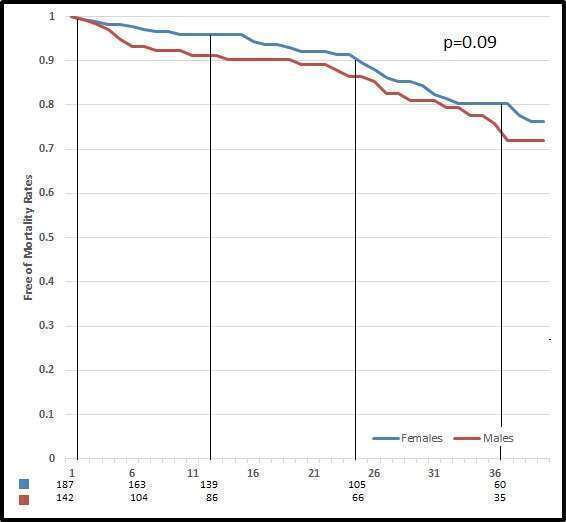Background: Whether female gender is associated with improved outcomes among patients with severe aortic stenosis undergoing transcatheter aortic valve implantation (TAVI) is still controversial. We aim to report a gender base comparative analysis of a cohort of patients following TAVI for the treatment of severe symptomatic aortic stenosis.
Methods: A cohort of 329 TAVI patients, mean follow up 886 days, was analyzed. Patients were divided according to their gender. Baseline characteristics, procedural features and clinical outcomes of both groups were compared according to the VARC2 criteria.
Results: The Cohort included 187(57%) females and 142(43%) males. Mean age was 82.4±5.9 in the female vs. 81.4±7 in the male group of patients; (p=0.7). Calculated EuroSCORE and STS score were 18.6±12.7 vs. 19.1±11.9 (p=0.8) and 7.3±4.2 vs. 7.6±3.9 (p=0.8), for females and males; respectively. Male patients, presented higher rates of previous CABG surgery [34%vs.9%; p<0.001] and a trend toward higher rates of diabetes mellitus [38.7%vs.25.6%; p=0.07]. No significant differences were observed in rates of peripheral vascular disease or COPD. At baseline, 98% of patients in each group were in NYHA-III/IV. Device success, according to VARC2 criteria, was achieved in 92.5% of female and in 93% of male patients (p=0.7). Procedural success was achieved in 95.7% of patients in both groups, p=NS. A permanent pacemaker was required in 19.1% of male vs. 13.9% of female patients, p=0.2. Survival rates for females vs. males at one month, one year and two years follow up were: 99.4% vs. 99.3%, 96% vs. 91.3% and 89% vs. 86.5% (p=0.09); respectively (Graph). Significant symptomatic improvement was observed in both genders.
Conclusion: In our experience, elderly female and male patients with severe aortic stenosis have similarly high long-term survival rates and excellent symptomatic improvement after TAVI.


